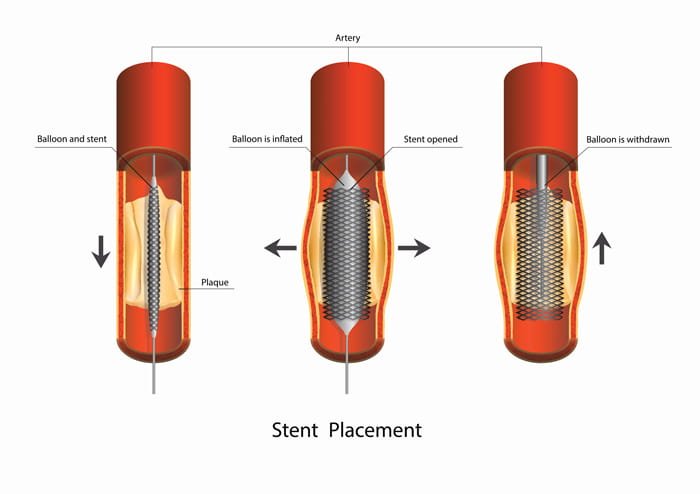Learn more about our top-ranked cardiologists and make an appointment:
What is a stent? Uses, risks and recovery
What is a Stent?
A stent is a small tube made from woven wires that is permanently placed in an artery (a blood vessel that transports blood from your heart to other body parts) to help keep it open. Simple stents are made from bare metal while newer generation stents also contain a drug coating that helps them stay open more permanently.
Stent placement is recommended when an artery has naturally become blocked or severely narrowed. This can happen when plaque (fatty deposits) form inside an artery, reducing blood flow to the heart. This reduced blood flow is called coronary artery disease and can cause chest pain.

When do you need a heart stent?
If you are experiencing any symptoms such as shortness of breath, chest pain (either at rest or with activity) unusual nausea or heartburn, it is important that you see your primary care physician or cardiologist as soon as possible. Additional tests may be ordered, or your doctor may recommend a cardiac catheterization. During a cardiac catheterization, an interventional cardiologist will be able to determine if you need a stent. You will receive light sedation for this procedure to eliminate anxiety. Early identification and treatment is extremely important and may prevent a significant, life-threatening cardiac event. If you experience chest pain that doesn’t go away and is concerning, call 911 immediately. This is preferred over driving yourself to the hospital because the paramedics can begin treatment upon arrival and also notify the hospital in advance.
Heart Stent Surgery and Procedure
The procedure to put in a stent is known as a percutaneous coronary intervention (PCI), or angioplasty with stent. During a PCI, an interventional cardiologist will insert a catheter (a thin, hollow tube) by making a small incision in a blood vessel in your arm or groin. The catheter will go through the blood vessel to the blocked artery. If a blockage or narrowing is identified, this area will be dilated with a balloon and permanently held open with a stent. The balloon is inflated to widen the narrowed vessel, and then is removed. The stent will remain in the artery. Stents become embedded into the vessel wall, and cannot be removed.
Heart Stent Benefits
A stent can save lives and offers benefits to most people who get one. Coronary stents can:
- Improve blood flow
- Prevent heart muscle from more damage
- Relieve symptoms of heart disease like chest pain and shortness of breath
- May eliminate the need for coronary artery bypass surgery
Heart Stent Risks
While the procedure is generally safe and simple, there are a few risks involved, and include:
- Blood vessel damage from the catheter
- Allergic reaction to dyes contrast or medications used during the surgery procedure
- Infection
- Bleeding at the site of the skin where the catheter was inserted
- Temporary Irregular heartbeat
Heart Stent Recovery
After receiving a stent, recovery from the procedure is usually a simple and quick process. Most people will need to stay in the hospital one or two nights to be monitored but then are sent home if no complications arise. There may be bruising or a small knot at the catheter site, but this is normal. You may be able to return to work and other normal activities the following week.
Your doctor may also tell you to take aspirin or another anti-platelet medication to help the stent from developing a clot and closing. You will likely remain on the anti-platelet medication for a year or sometimes longer. Never stop taking these medications until a cardiologist instructs you to do so. This would place you at risk of your stent becoming blocked and causing a heart attack.
Here are some steps to help you have a successful recovery:
- Take all of your medications as directed and don't stop until your cardiologist doctor tells you to.
- If you notice any pain, swelling, redness or other issue regarding your procedure, contact your doctor to ensure your recovery is going well.
- Do not do any intense exercise programs or lift heavy objects after your procedure. Your doctor will let you know when you can return to exercising.
- Listen to your doctor and go to your follow-up appointments to ensure you're making a full recovery.
How long does a stent last for?
A heart stent can last as long as a person lives, so it will be with you for the rest of your life. Although rare, it is possible that the same area can become re-narrowed -even if you follow your cardiologist’s instructions. Should this occur, another stent may be placed in the same location.
People who have stents and other heart disease or other heart conditions need to make lifestyle changes that help reduce the risk of future blockages. Here are some things you can do to reduce your risk of developing more issues:
- Participate in a cardiac rehabilitation program with your cardiologist.
- Eat a heart-healthy diet.
- Exercise regularly
- If you smoke, stop.
- If you are overweight or obese, lose weight according to your doctor.
- Keep blood pressure and cholesterol (and other conditions like diabetes) under control
- Visit your heart doctor as prescribed and reach out with any issues
If you are experiencing any symptoms that may relate to your heart health, you should see a cardiologist or ask your primary care physician about seeing one.


